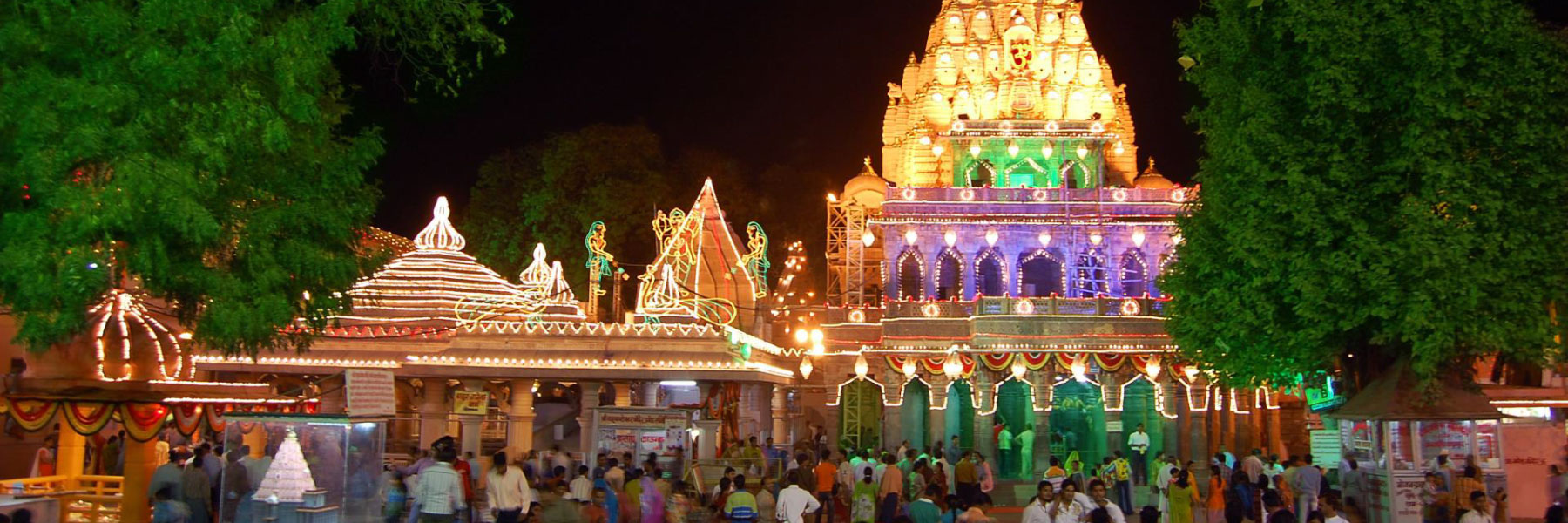
Sorry, we couldn't find anything that matches your search.
Destination

Famous Places to Explore in Hyderabad
A vibrant city with the imposing...

Raipur Tourist Places | Best Place to Visit
The stronghold of several erstwhile...

Ahmedabad
Declared as India's first UNESCO World...
#
Siddhavat
Bestowed with the same religious sanctity as Vanshivat in Vrindavan and Akshayvat in Gaya, Siddhavat is a huge banyan tree on the banks of River Kshipra. Pegged as a paap-mochan (sin purifier) teerth, the tree is believed to have been planted by Goddess Parvati when she had come to worship and perform penance. Saints of the Nath cult throng this place all-year-round to worship and meditate. There is a restaurant in the vicinity for pilgrims and travellers to relax in. Devotees also take a holy dip in the sacred Kshipra river. This is believed to wash away their sins. The temple opens as early as 4 am and a lot of visitors come here on Sarvapitra Amavashya to pray for the peace of the departed souls.

Mangalnath Temple
Located on the outskirts of the city, Mangalnath Temple is among the most important shrines on the tourist circuit. The presiding deity of the temple is Lord Shiva or Mahadeva, who is worshipped by devotees from far and wide. According to Matsya Purana, the Mangalnath Temple is considered to be the birthplace of Mars. It is said that during ancient times, the temple was one of the best places to get a clear view of Mars and a great spot for astronomical studies. Located on the banks of River Kshipra, the temple is associated with the belief that it will rid visitors of their dark energies and problems. From here, visitors can also get a picturesque and sweeping view of the holy Kshipra river.

Gopal Mandir
Located at the heart of the market square, Gopal Mandir is a glorious example of Maratha architecture. It was constructed in the 19th century by the Queen of Maharaj Daulat Rao Shinde- Bayajibai Shinde. A towering marble structure, the temple is dedicated to Lord Krishna. While the sanctum sanctorum has been inlaid with marble and has silver-plated doors along with a patch of gemstone plate, the inner sanctum was taken away to Ghazni. Thereafter, it was taken to Lahore by Mahmud Shah Abdali. The sanctum sanctorum houses the idols of Lord Krishna (black) and Goddess Radha (white). There are also statues of Devi Rukmani and Shiv Parvati on either side of the main shrine. The temple hosts a grand celebration annually on the occasion of Bhadrakrishna Janmashtami.

Gomti Kund
Once a major source of water for Sandipani Ashram, Gomti Kund, is a water tank that is set amidst serene environs. It is believed that taking a dip in the sacred water of the tank can help cure the problems of devotees, who come here to pray. According to legend, Lord Krishna collected the water of holy rivers from different pilgrimage centres and put it in here. The kind is also home to a lot of monkeys! The Sandipani Ashram is named after the saint who was the teacher of Lord Krishna and his brothers. The ashram has a temple dedicated to Lord Shiva that is a must-visit while you are at the kund. At this temple, the figure of Nandi (bull god) stands guard in front of Lord Shiva.

Gadkalika Temple
Located a stone's throw from the city, Gadkalika Temple is dedicated to Goddess Kalika. Legend states that poet Kalidasa, though formally uneducated, was able to acquire unparalleled literary knowledge and skills because of blessings by this Goddess that he was utterly devoted to. Goddess Kalika is associated with universal energy. At the entrance of the temple, devotees are met by a sculpture of a lion that is facing towards the stone deity who is painted saffron with a crown of silver sitting prettily on the head. The building has a hollow, pyramid-shaped dome with layers carved into it. Devotees can also pay their respects to the idol of Lord Ganesha within the grounds. Though the origins of the temple remain unknown, it was once renovated by emperor Harshvardhan, ruler of the Vardhana dynasty (606-647 CE) in the 7th century AD and once again during the Paramara period (9th to 14th centuries). The current structure of the temple was given its shape by the erstwhile state of Gwalior.

Mahakaleshwar Temple
One of the 12 jyotirlingas in the country and among the most prominent temples in Ujjain, Mahakaleshwar Temple is dedicated to Lord Shiva. The lingam (a symbolic representation of Lord Shiva) at Mahakaleshwar resides in a subterranean chamber and is believed to be swayambhu or self-manifested. The present temple is a five-storey structure and was constructed midway during the 18th century. Built in Bhumija, Chalukya and Maratha styles of architecture, the temple is an architectural marvel. Of note are its marble walkways that were restored in the latter half of the 19th century by the Scindias. Three floors of the building are occupied by lingams of Mahakalesvara, Omkaresvara and Nagachandresvara, respectively. The Nagachandresvara lingam is accessible for devotees only on the occasion of Naga Panchami. There is also a kunda (tank) in the premises called Koti Tirtha that has been built in the sarvatobhadra style. On the path from the stairs of the kunda to the temple you will come across several images of the original structure of the temple, reflecting its grandeur during the period of the Paramaras (9th and 14th centuries). Located near Rudra Sagar, the temple holds a special Bhasma Arti for which devotees gather here as early as 4 am. There is an enthusiastic vibe in the air and the lit diyas make for a stunning sight.

Kal Bhairava Temple
On the banks of River Kshipra stands the Kal Bhairava Temple, which is believed to have been built by King Bhadresen. Worshipping eight Bhairavas (incarnations of Lord Shiva) has been a tradition for the Shaivite sect devotees with Kal Bhairava being the chief among them. In Avanti Khanda (a chapter) of the Skanda Purana (religious text), there is a mention of Kal Bhairava Temple and it is believed that worshipping here has always been a part of the Aghora and Kapalika sects as well. Images of Lord Shiva, Goddess Parvati, Lord Ganesha and Lord Vishnu were once recovered from the temple. The current temple structure reflects the Maratha architectural style. Traces of paintings made in Malwa style are still visible on the walls of the temple. The village of Bhairogarh, where the temple is situated, is also known for a certain art form of printing.

Ujjain Simhast Kumbh
Kumbh Mela is probably the largest spiritual gathering in the world, held in four parts of India - Haridwar, Ujjain, Prayagraj and Nashik. It is held every four years in one of the four cities. The fair held in Ujjain is called Simhasth Kumbh Mahaparv and is held on the banks of the holy Kshipra river. It is widely considered as a Hindu pilgrimage in which devotees from all over the globe come together to take a dip in the sacred river. This is in effect to the belief that taking a dip in the waters would absolve them of their sins. The mela itself is a vibrant and awe-inspiring event and a great place to soak in culture and tradition.





